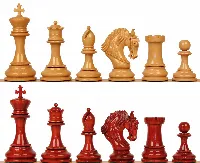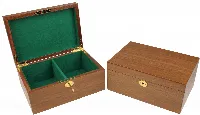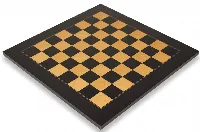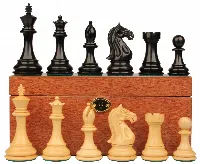Choosing Your Battlefield: Selecting Your Perfect Chess Set


The Art of Choosing Your Chess Set
Embarking on the quest to find the perfect chess set is both an exciting adventure and a testament to the timeless allure of the game itself. This journey transcends mere acquisition, inviting players into the nuanced world of craftsmanship, aesthetics, and personal expression. Whether you're a seasoned strategist seeking the precision of tournament-standard pieces or a casual enthusiast drawn to the beauty and history embodied in each set, the art of choosing your chess set is about finding a balance between functionality, style, and the deep, personal connection that elevates every match played.
From Ancient Battlefields to Modern Homes
Chess, a game that transcends time and cultures, has long been more than just a pastime. It's a blend of art, intellect, and history, embodying the strategic battles of ancient times in the confines of an 8x8 square board. The choice of a chess set is thus not merely about picking playing pieces; it's about selecting a companion for a journey through the realms of logic, strategy, and beauty. Each set tells a story, from the meticulously carved knights and pawns that echo the chivalry of medieval times to the sleek, modern designs that reflect our contemporary aesthetic.
Why Your Choice Matters: More Than Just a Game
Choosing the right chess set is akin to finding the right instrument for a musician. It's not just about the physical appearance but how it feels in your hands, the sound of a piece being placed with decisive precision, and how it complements the space where you think, strategize, and conquer. A well-chosen set can inspire and elevate your game, turning each move into a tactile experience that connects you more deeply with the history and the essence of chess.
Your chess set can be a statement of personal style, a tool for sharpening your strategic skills, or a cherished heirloom to be passed down through generations. Whether you're a beginner drawn to the game's intellectual challenge or a seasoned player with a deep appreciation for its complexity, the right chess set becomes a treasured part of your journey. It's about creating a connection that enhances the joy, the learning, and the experience of play.
As we explore the art of choosing your chess set, remember that this decision is not just about functionality. It's about finding a set that resonates with your spirit, complements your skill level, and brings joy to every game. Whether it will grace your home as a piece of decor, serve as a faithful companion through countless matches, or become a gift that carries your love for chess to another, the perfect chess set awaits. Let's embark on this journey together, discovering how to select a set that not only meets your needs but also captures your heart.
Understanding Chess Set Components: Pieces, Board, and Box
Kings, Queens, and Pawns: The Characters of the Game
At the heart of every chess set are the pieces themselves, each with its unique role and power on the board. The design of these pieces can range from the highly abstract to the intricately detailed, reflecting not only a rich history but also the personality of their owner. The king, with its imposing presence, must be protected at all costs, while the queen combines power and elegance as the game's most versatile piece. Knights, bishops, and rooks bring their own strategic value to the game, and the humble pawn, often underestimated, can become the key to victory. The choice of pieces is deeply personal, affecting not just the aesthetics of the game but also the tactile experience of play. It's important to select pieces that are not only visually appealing but also comfortable to handle and move across the board.
The Battlefield: Selecting the Right Board
The chessboard itself is a battlefield, where strategy and fate unfold. The choice of board is as crucial as the selection of pieces. It must not only match the size and style of your pieces but also complement the environment in which it will be displayed or used. Boards come in various materials, such as wood, marble, glass, or leather, each offering a different look and feel. The color contrast between the squares is vital for clear visibility, but the choice of color scheme can also add a personal touch to your set. The board should have a smooth surface that allows pieces to glide across it effortlessly, enhancing the physical experience of the game.
The Guardian of the Game: Choosing a Protective Box
A chess set, with its intricate pieces and board, is an investment in both mental enrichment and aesthetic pleasure. Protecting this investment is where the box or case comes into play. A good storage solution not only keeps your pieces safe and organized but also adds to the overall appeal of the set. Whether it's a beautifully crafted wooden box, a durable travel case, or a luxurious leather pouch, the right storage option ensures that your chess set remains in pristine condition for years to come. Consider the ease of access, the protection it offers, and how it complements your chess set's design when choosing the perfect guardian for your game.
The Significance of Material: Wood, Plastic, Metal, and Beyond
Nature's Craft: The Elegance of Wood
Wooden chess sets stand as the quintessential choice for players and collectors alike, revered for their classic beauty and tactile warmth. Crafted from woods like maple, walnut, rosewood, and ebony, these sets offer a spectrum of colors and grains, making each piece a unique work of art. The weight and durability of wood, along with its timeless appeal, make wooden chess sets a popular choice for both casual play and professional tournaments. The craftsmanship involved in carving each piece can range from the straightforward and functional to the ornately detailed, appealing to a wide range of tastes and preferences.
Modern Touch: Plastic's Practicality and Variety
Plastic chess sets have surged in popularity due to their affordability, durability, and versatility. Ideal for beginners, schools, and chess clubs, these sets can withstand the rigors of frequent use and travel without losing their functional integrity. The advent of high-quality, weighted plastic pieces has bridged the gap between practicality and the desire for a more substantial feel during play. Moreover, plastic sets offer a vast array of designs and colors, allowing for personal expression and visibility during the game. They serve as an excellent entry point for new players and a practical option for seasoned enthusiasts seeking a robust set for regular use.
Heirlooms of the Future: The Prestige of Metal Sets
Metal chess sets, crafted from materials like brass, silver, and pewter, offer a distinctive weight and elegance that set them apart. These sets are often chosen for their aesthetic appeal and the luxurious feel of the pieces as they move across the board. Metal sets can range from the sleek and contemporary to the elaborately themed, capturing historical battles or mythical tales through their design. They are cherished not only for their gameplay but also as decorative pieces and collectibles that embody the fusion of art and strategy. A metal chess set is frequently seen as an investment piece, an heirloom to be admired and enjoyed by generations.
Beyond Tradition: Exploring Unconventional Materials
Innovation in chess set design has led to the use of unconventional materials, expanding the horizons of what a chess set can be. Glass, stone, and even bone are being used to create sets that challenge traditional aesthetics and offer unique tactile experiences. Glass chess sets, with their transparent and frosted pieces, add a contemporary elegance to the game, transforming each move into a play of light and shadow. Stone sets, carved from marble or onyx, bring a stately, grounded feel to the board. Meanwhile, sets made from bone or other exotic materials hark back to the ancient origins of chess, offering a raw and organic appeal.
Size Matters: Matching the Board to the Pieces
Selecting the perfect chess set involves not just an appreciation for the material and design but also a keen eye for the right size and proportions. The harmonious relationship between the board and the pieces is crucial for aesthetic appeal, practical playability, and overall satisfaction.
A Game of Proportions: Finding the Perfect Fit
The first rule of thumb in matching chess pieces to a board is ensuring that the base of the pieces is not too large for the squares on the board. A general guideline suggests that the diameter of the piece's base should be about 75% of the width of a square. This proportion allows for enough space between the pieces to move and be positioned comfortably, enhancing the visual clarity and playability of the game. It's not just about the pieces fitting on the board; it's about them belonging there, with each piece clearly distinguished from its neighbors.
Space and Playability: Ensuring Comfort in Play
Beyond aesthetics, the size of the board relative to the pieces impacts the tactile experience of the game. A board that's too cramped can make moving pieces awkward and detract from the strategic depth of play. Conversely, a board that's too large for its pieces can make the game feel dispersed and lessen the intensity of the battle being waged. Ideal spacing allows players to execute moves with precision and ease, making the game more enjoyable and engaging.
The size of the board also plays a significant role in the setting where the chess set will be used. For a coffee table or display piece, a larger board might serve as an impressive centerpiece, while for a tournament or club play, the standard board size ensures fairness and consistency. The environment, intended use, and personal preference should all factor into the decision-making process.
The Importance of Scale in Design
When considering the scale, it's not just the functional aspects that matter but also the aesthetic ones. A well-proportioned set, where the pieces are neither dwarfed by the board nor overwhelming it, creates a visual harmony that enhances the beauty of the set as a whole. The size should reflect the design intentions, whether to stand out as a statement piece in a room or to serve as a portable set for travel. The visual impact of a chess set, with its pieces poised for battle on a perfectly matched board, can be a source of inspiration and admiration.
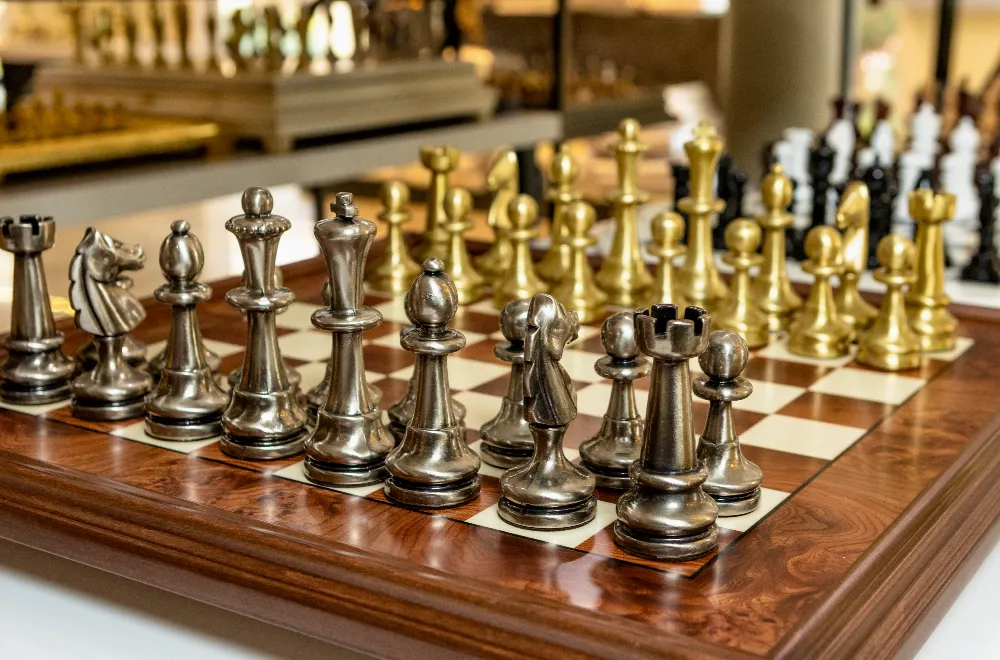
Style and Aesthetics: Classic vs. Modern Designs
The choice between classic and modern chess sets is not merely a matter of taste but a reflection of one's personal connection to the game, its history, and its future.
Timeless Elegance: The Beauty of Classic Sets
Classic chess sets are revered for their historical significance and timeless beauty. These sets often adhere to traditional designs, such as the Staunton pattern, which has been the standard for tournament play since the late 19th century. Classic sets are characterized by their familiar shapes, with each piece easily recognizable by its form and function. Crafted from wood, marble, or even bone, these sets exude a warmth and elegance that appeal to purists and those who appreciate the game's rich history.
The appeal of classic chess sets lies in their enduring beauty and the connection they offer to the past. Playing with a classic set can evoke the grandeur of historic matches and the legends who played them, providing inspiration and a sense of continuity. These sets are not just tools for the game but heirlooms that can be passed down through generations, carrying stories and memories with them.
The New Age: Modern Designs and Innovations
Modern chess sets, on the other hand, break away from traditional designs, embracing innovation and contemporary aesthetics. These sets are often made from materials like plastic, glass, or metal, featuring sleek lines, abstract shapes, and innovative themes. Modern designs can range from minimalist to thematic, offering a wide array of choices that reflect the individuality of the player.
The allure of modern chess sets lies in their ability to blend the ancient game with contemporary culture, making chess accessible and appealing to new generations of players. These sets can serve as conversation starters, decorative pieces, or personal statements, reflecting the player's personality and modern sensibilities. The innovative use of materials and design not only challenges the conventional but also opens up new possibilities for creativity and expression within the game.
Blending Worlds: Fusion Styles
For those who find themselves drawn to both the classic and the modern, there exists a middle ground in fusion-style chess sets. These sets skillfully blend traditional craftsmanship with contemporary design elements, offering the best of both worlds. Fusion sets might feature classic shapes crafted from modern materials or traditional materials shaped into modern forms. This hybrid approach allows for a unique chess-playing experience, where history meets innovation in every piece.
The Importance of Weight and Balance in Chess Pieces
Selecting a chess set involves considerations that go beyond mere aesthetics. The weight and balance of the chess pieces play a pivotal role in the tactile experience of the game, influencing both the comfort and precision of play.
The Feel of the Game: How Weight Influences Play
The weight of chess pieces is a subtle yet powerful aspect that impacts the game's dynamics. Weighted pieces feel more substantial and stable in the hand, offering a satisfying sensation when moved or placed on the board. This heft prevents pieces from being easily knocked over during play, adding a level of seriousness and professionalism to the game. For many players, the weight of the pieces is synonymous with quality; heavier pieces are often perceived as more luxurious and desirable.
In tournament play, weighted pieces are the standard, as they ensure a uniform playing experience and reduce the likelihood of disruptions. For casual players, the weight of the pieces can enhance the sensory pleasure of the game, making each move feel more deliberate and significant.
In Perfect Harmony: The Role of BalanceBalance, while closely related to weight, refers to how evenly the mass of a piece is distributed. A well-balanced chess piece stands securely on the board, does not tip over easily, and feels comfortable to hold and move. The base of the piece, often felted with a smooth material, plays a crucial role in achieving this balance, ensuring smooth movement across the board without scratching or damaging the surface.
The balance of a piece can significantly affect the player's confidence and speed during the game. Pieces that are top-heavy or poorly balanced can lead to fumbling or accidental tipping, disrupting the flow of play and detracting from the strategic focus of the game. Conversely, well-balanced pieces complement the player's skill, allowing for swift, precise movements that keep the game moving at an enjoyable pace.
Choosing the Right Weight and Balance
When selecting a chess set, consider the weight and balance of the pieces as key factors in your decision. While personal preference plays a significant role, there are general guidelines that can help. Tournament-style pieces, with their standard weight and balance, offer a good benchmark for serious players. For casual play, the choice may lean more towards aesthetic preference, but the tactile experience should not be overlooked. Holding and moving the pieces before purchase, if possible, can provide valuable insight into their feel and functionality.
Testing the balance of a piece can be as simple as ensuring it stands upright without wobbling and moves smoothly across the board. For weight, compare different sets to find what feels most comfortable and satisfying for your style of play. Remember, the best chess set is one that not only looks appealing but also feels right in your hands, enhancing every aspect of the game.
Tournament Standards vs. Home Use: What's Right for You?
When selecting a chess set, one of the key decisions you'll face is choosing between a set that meets tournament standards and one designed for casual, home use. This choice significantly influences not just how you enjoy the game but also how the set fits into your lifestyle and aspirations in the world of chess.
Playing by the Rules: Understanding Tournament Specifications
Tournament standard chess sets adhere to specific guidelines set forth by chess federations, designed to ensure uniformity and fairness in competitive play. These specifications include the size of the board, the height and base diameter of the pieces, and even the weight of the pieces. For instance, the King's height is typically around 3.75 inches, and the board should have squares about 2 to 2.5 inches in size. The pieces are often weighted to provide stability and a satisfying heft during play.
If you're aspiring to compete in tournaments or simply enjoy practicing under competition conditions, a tournament-standard set is essential. These sets prepare you for the environment you'll encounter in competitive play, making the transition seamless and comfortable. Moreover, practicing with a set that mirrors what you'll use in tournaments can enhance your spatial perception and strategy execution, critical aspects of improving your game.
Leisure and Legacy: Sets for Home Use and Collection
Chess sets designed for home use prioritize aesthetics, craftsmanship, and personal preference over strict adherence to tournament regulations. These sets come in a wide range of materials, designs, and sizes, allowing for a more expressive and decorative approach to selecting a chess set. From ornate wooden pieces that accentuate your home decor to themed sets that reflect your personal interests or historical periods you admire, the options are virtually limitless.
Home use sets can still offer excellent playability and comfort, but with an added emphasis on the set's visual and tactile appeal. They can serve as conversation starters, educational tools for children, or simply as a way to enjoy casual games with friends and family. For collectors, unique or antique sets can be a source of pride and joy, representing not just a love for the game but also an appreciation for art and history.
Making Your Selection: Balancing Aspirations with Lifestyle
Choosing between a tournament-standard set and a home use set ultimately comes down to your aspirations in chess and how you envision the game fitting into your life. Consider the following questions to guide your decision:
- Do you plan to compete in official tournaments, or is chess primarily a leisure activity for you?
- How important is the aesthetic appeal of the set versus its conformity to competitive standards?
- Is the chess set intended to be a focal point in your home, a collector's item, or a practical tool for improving your game?
For some, the ideal solution might be owning two sets: one that meets tournament standards for serious practice and competition, and another that reflects personal style and enhances the home environment. This approach allows you to enjoy the best of both worlds, catering to your competitive ambitions and your love for the game's artistic and historical aspects.
Custom and Themed Chess Sets: Expressing Your Personality
Chess is not just a game of strategy and intellect; it's also a medium for personal expression and creativity. Custom and themed chess sets offer players a unique opportunity to infuse their love for the game with their interests, passions, and aesthetic preferences.
Personal Tales: Custom Sets Tailored to You
Custom chess sets are designed to meet the specific desires and imagination of an individual. Whether it's a set featuring pieces carved in your likeness, designed to represent family members, or crafted to incorporate elements of your profession or hobbies, custom sets make the game deeply personal. The process of creating a custom set can involve working with skilled artisans who translate your vision into reality, using materials, designs, and motifs that speak to your personal story or aesthetic sensibilities. Custom sets can be as straightforward or as elaborate as you wish, from simple engravings to elaborate thematic representations, making each game an intimate reflection of yourself.
A World of Fantasy: Themed Sets from History and Fiction
Themed chess sets take inspiration from a wide array of sources, including history, literature, cinema, and mythology. These sets can transport players to ancient Rome, the battlefields of the Middle Ages, the realms of fantasy epics, or the far reaches of space. Themed sets can also pay homage to beloved characters from movies, books, or television series, allowing fans to play out their own battles and strategies in the context of their favorite stories.
The appeal of themed chess sets lies in their ability to make each game an immersive experience. Playing with a set that captures the essence of a historical era, a fictional universe, or a cultural phenomenon adds an extra layer of enjoyment and engagement to the game. For collectors and enthusiasts, themed sets are not just tools for play but also pieces of art that celebrate their interests and passions.
Expressing Your Personality Through Chess
Choosing a custom or themed chess set is a way of making the game truly your own. It's an opportunity to showcase your personality, interests, and creativity every time you set up the board. Whether you're drawn to the elegance of historical themes, the excitement of fantasy and adventure, or the personal touch of a custom-made set, your choice adds depth to the game, making it a more meaningful and enjoyable part of your life.
When selecting a custom or themed chess set, consider not only the aesthetic appeal but also the quality of craftsmanship and playability. A well-designed set will not only look impressive but also provide a comfortable and satisfying gaming experience. It's also worth considering the set's durability and the materials used, especially if it will be used frequently or displayed prominently in your home.
Durability and Maintenance: Ensuring Longevity
A chess set is not just a collection of pieces and a board; it's an investment in countless hours of intellectual challenge, enjoyment, and sometimes, a beautiful addition to your home decor. Ensuring the longevity of your chess set through proper durability and maintenance is crucial.
Built to Last: Choosing Durable Materials
The choice of material directly impacts the durability of a chess set. Wood, metal, stone, and high-quality plastics are among the most durable materials, each with its unique properties and care requirements.
- Wood: Renowned for its classic appeal and warmth, wooden chess sets require protection from extreme temperatures, humidity, and direct sunlight to prevent warping, cracking, or fading. Hardwoods like maple, walnut, rosewood, and ebony are preferred for their resistance to wear and tear.
- Metal: Chess sets made from metals such as brass, bronze, or pewter offer significant durability and a unique aesthetic. They are less prone to damage from falls or knocks but can tarnish over time without proper care.
- Stone: Marble and alabaster chess sets provide a luxurious feel and substantial weight. These materials are prone to chipping or scratching if mishandled, so they require careful use and storage.
- High-Quality Plastics: Ideal for more casual or educational use, high-quality plastics can offer durability for frequent handling, making them suitable for young players or chess clubs.
Caring for Your Set: Maintenance Tips
Regular maintenance not only keeps your chess set looking beautiful but also preserves its functionality and value. Here are some material-specific tips to help you care for your set:
- Wood: Dust your wooden chess pieces and board regularly with a soft, dry cloth. Use a wood cleaner or polish sparingly to maintain the shine, avoiding silicone-based products that can build up over time. Keep the set in a stable, humidity-controlled environment.
- Metal: Polish metal pieces occasionally with a suitable metal cleaner to maintain their luster. For antique metal sets, consider consulting a professional before using any cleaning products, as some may be too abrasive.
- Stone: Wipe stone chess sets with a soft, damp cloth to remove dust. Avoid using acidic cleaners that can etch the surface. For deeper cleaning, use a mild soap solution and dry immediately to prevent water spots.
- Plastic: Plastic sets are the easiest to maintain, requiring only a wipe down with a damp cloth. For stubborn stains, a mild soap solution can be used. Avoid harsh chemicals that can degrade the plastic over time.
Storage and Handling
Proper storage and handling are essential for protecting your chess set from damage. Store the pieces in a sturdy box or case lined with soft fabric to prevent scratches. Ensure the board is stored flat to avoid warping. When transporting the set, especially if it's made of fragile materials like glass or stone, secure it in padded packaging to prevent movement and potential damage.
Budgeting for Your Chess Set: From Affordable to Luxury Options
Investing in a chess set can be as modest or as lavish an affair as your budget and preferences dictate. From affordable, practical options perfect for beginners or casual players, to exquisite luxury sets that are as much a collector's item as they are a functional game, there's a wide range to suit every pocket and purpose.
Economical Choices: Finding Value in Every Price Range
Starting with affordable options, it's possible to find high-quality chess sets that won't break the bank. Plastic and certain wooden sets offer durability and aesthetic appeal without a hefty price tag. These sets are ideal for players who prioritize functionality and are perhaps looking for a sturdy, reliable set for frequent use, travel, or to gift to a young or new enthusiast of the game.
- Plastic Sets: Often lightweight, durable, and very cost-effective, plastic chess sets are perfect for schools, clubs, and beginners.
- Basic Wooden Sets: Offering a step up in terms of aesthetic, simple wooden sets can be found at reasonable prices and provide a more traditional playing experience.
When budgeting for an economical chess set, consider sets that offer the best balance between quality and price. Look for sets with a solid feel, good craftsmanship, and positive reviews, ensuring they will provide a satisfying experience and stand up to regular use.
Splurging with Sense: Investing in Luxury
For those with a larger budget or seeking to make a significant investment, luxury chess sets are crafted from premium materials like high-grade woods, metals, and even precious stones. These sets are often hand-carved and meticulously detailed, making them as much a work of art as a playable set.
- Collector's Items: Limited edition sets, historical replicas, and sets crafted by renowned artisans can serve as magnificent display pieces and are often sought after by collectors.
- Exotic Materials: Sets made from materials like ebony, marble, silver, or even gold, offer unparalleled beauty and craftsmanship, reflecting the owner's taste and passion for the game.
Investing in a luxury chess set involves considering not only the upfront cost but also the value it adds to your collection or home. Luxury sets can appreciate over time, especially those that are rare, making them not just purchases but investments.
Budgeting Tips
- Define Your Primary Use: Decide whether the set will be used primarily for play, display, or as an investment. This decision can help guide your budgeting, as functional sets may not need to be as costly as showpieces or collectors' items.
- Research and Compare: Spend time researching different types and styles of chess sets within your budget. Compare prices across vendors to find the best deal.
- Consider Longevity: It may be worth spending a bit more on a set that will last longer and offer a better playing experience than a cheaper, less durable option.
- Watch for Deals: Sales, auctions, and second-hand purchases can be great ways to find high-quality sets at a lower price. However, ensure the authenticity and condition of the set before buying.
Where to Buy: Navigating Retailers and Online Marketplaces
Finding the perfect chess set involves not just deciding on the type, style, and budget, but also knowing where to look. The market for chess sets spans from local specialty stores to vast online marketplaces, each offering different advantages.
Specialty Chess Shops
Pros: Specialty chess shops, often run by enthusiasts and experts, provide a curated selection of chess sets for all levels and budgets. These stores offer the advantage of personalized service, allowing you to see, touch, and even try out sets before purchasing. Staff can offer valuable advice on the best set for your needs, based on their extensive knowledge.
Cons: The main drawback is that specialty stores may have higher prices due to their focused inventory and expert services. Additionally, their selection, while high-quality, might be limited compared to broader marketplaces.
Online Chess Retailers
Pros: Dedicated online chess retailers offer a wide variety of chess sets from around the world, often at competitive prices. Their websites may provide detailed product descriptions, reviews, and images, helping you make an informed decision from the comfort of your home. Many offer customer support and return policies that mitigate the risks of online shopping.
Cons: Without the ability to physically inspect the chess set, there's a reliance on the accuracy of descriptions and the quality of photos. Shipping costs and the wait for delivery are also considerations.
General Online Marketplaces
Pros: Platforms like Amazon, eBay, and Etsy offer vast selections of chess sets, from affordable options to unique, handmade pieces. The competitive environment can lead to better deals, and user reviews provide insight into the quality and reliability of the products and sellers.
Cons: The overwhelming variety can make the search time-consuming, and the quality of products can vary widely. It's important to vet sellers carefully, especially when purchasing high-value or antique sets.
Local Artisans and Craft Fairs
Pros: Buying from local artisans or at craft fairs not only supports small businesses and craftspeople but also gives you access to unique, often customizable chess sets. This option allows for a personal connection with the maker and a story behind your chess set.
Cons: The availability of chess sets might be limited, and prices can be higher due to the craftsmanship and materials used. Finding these opportunities requires more effort and timing.
Antiques Shops and Auctions
Pros: For those interested in historical or collectible chess sets, antiques shops and auctions can be treasure troves. These venues often offer pieces with rich histories and unique designs not found in regular stores.
Cons: Knowledge about chess set authenticity and condition is crucial when shopping in these venues to ensure a wise investment. Prices can be high, and bargains are rare.
Tips for Buying
- Do Your Homework: Research the type of chess set you want and compare prices and reviews across different retailers.
- Check Return Policies: Especially when shopping online, understanding the return policy can save you from being stuck with a set that doesn't meet your expectations.
- Ask Questions: Don't hesitate to contact sellers with any questions about the chess set, whether it's about the material, size, or origin.
The Final Move: Making Your Selection
Choosing the perfect chess set is a journey that combines personal taste, practical considerations, and, often, a touch of sentimentality. As you stand on the cusp of making your final selection, it's crucial to reflect on the factors that have guided you to this point. This concluding section aims to encapsulate the essence of that journey, offering a checklist to ensure your decision aligns with your desires, needs, and aspirations in the realm of chess. Here's how to make that final move with confidence and satisfaction.
Checklist for Choice
- Material and Craftsmanship: Ensure the chosen set's material resonates with your aesthetic preferences and meets your expectations for durability and maintenance. The craftsmanship should reflect the value you seek in a chess set, whether it's for regular play, display, or collection.
- Size and Proportion: Verify that the size of the board and the pieces are compatible and appropriate for the space where you'll play or display the set. The pieces should be comfortable to handle, with the board offering clear visibility and a pleasing layout.
- Style and Design: Consider whether the set's style - classic, modern, themed, or custom - truly speaks to your personality and how you envision your chess playing experience. It should inspire you, whether through its historical significance, artistic merit, or personal connection.
- Functionality vs. Aesthetics: Balance the practical aspects of playability and the set's aesthetic appeal. It's important that the set serves its primary purpose, whether that's for serious gameplay, teaching, or as a decorative piece.
- Budget Considerations: Confirm that the chess set fits within your budget, providing value for money without compromising on the essential qualities you seek. Remember, a higher price doesn't always equate to higher satisfaction.
- Purchase Source: Reflect on the reliability and reputation of the source from which you're buying the chess set. Whether it's a specialty store, online retailer, or an artisan, ensure they offer quality customer service and support.
Embarking on the Journey
Making your selection is not merely the culmination of your search but the beginning of a new chapter in your chess journey. This chess set will be your companion through countless games, a participant in your moments of triumph, contemplation, and growth. It may even become a legacy piece, passed down with stories of epic battles and personal achievements.
